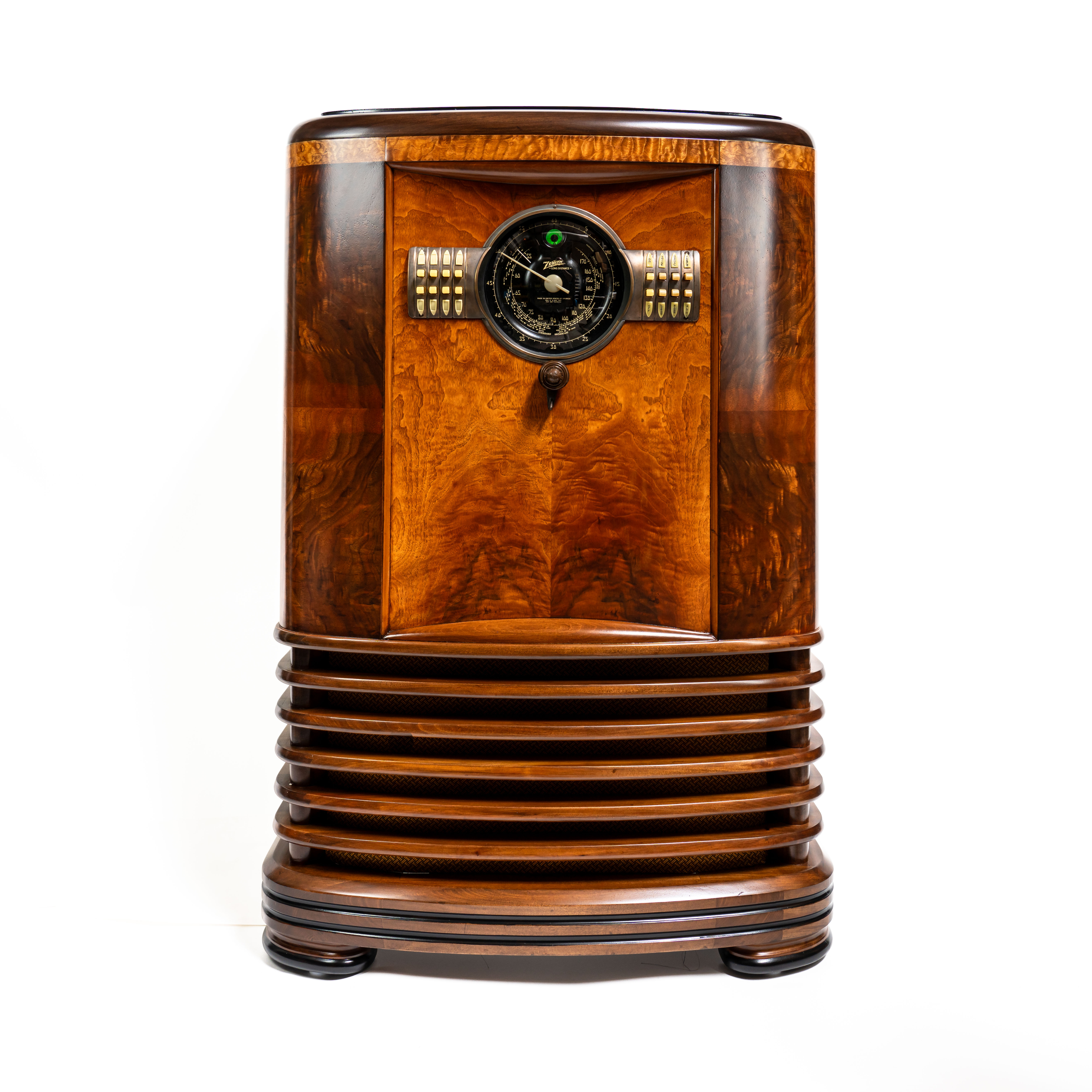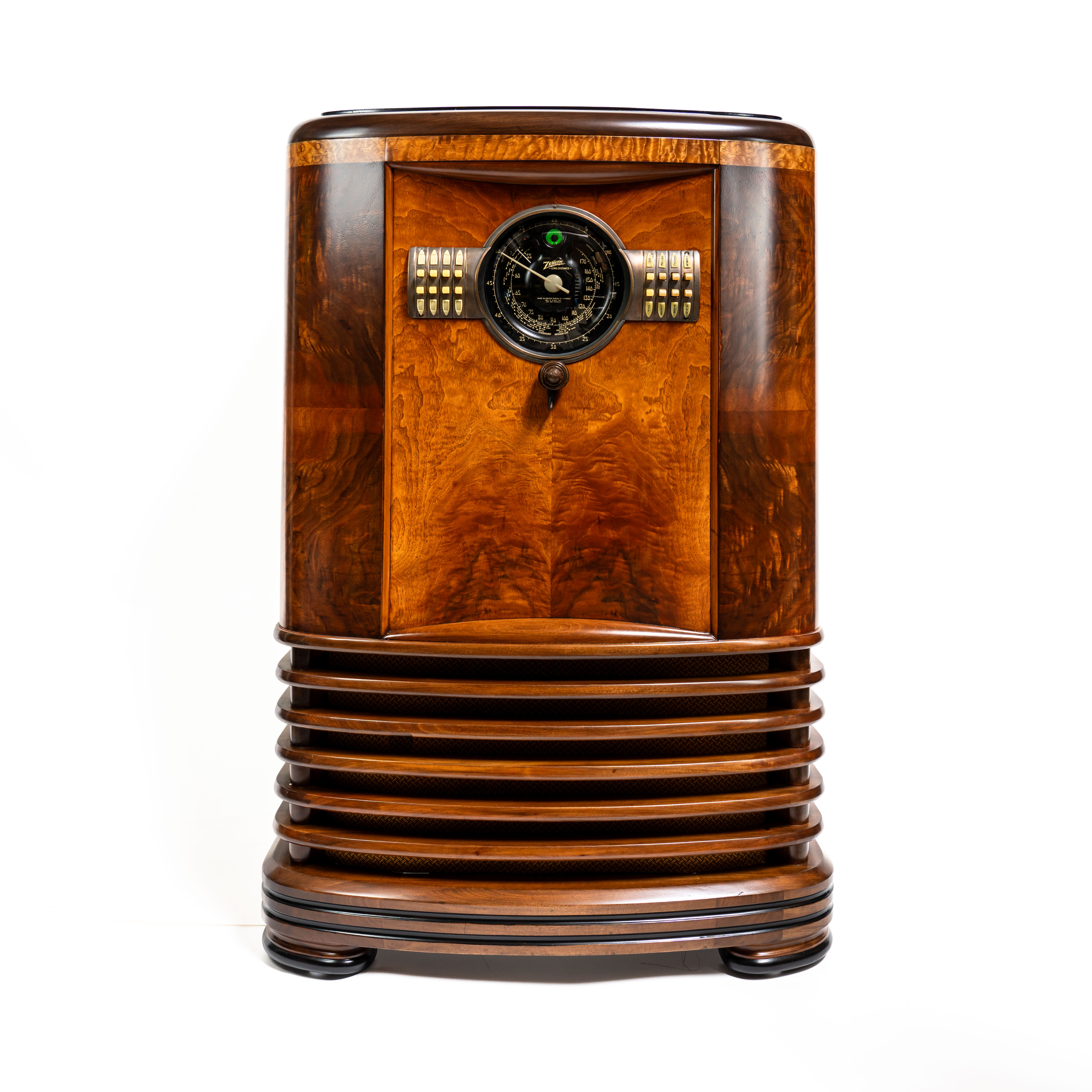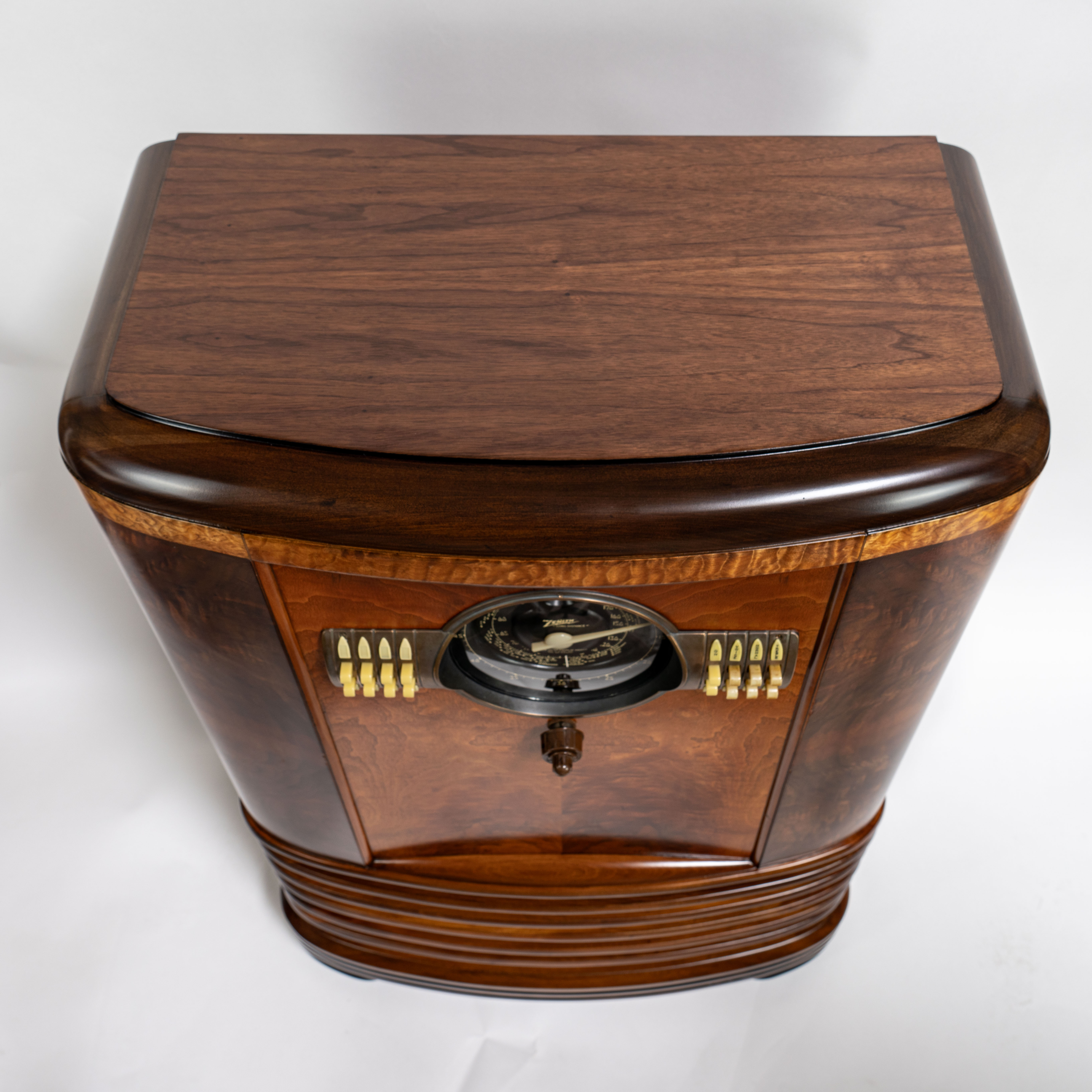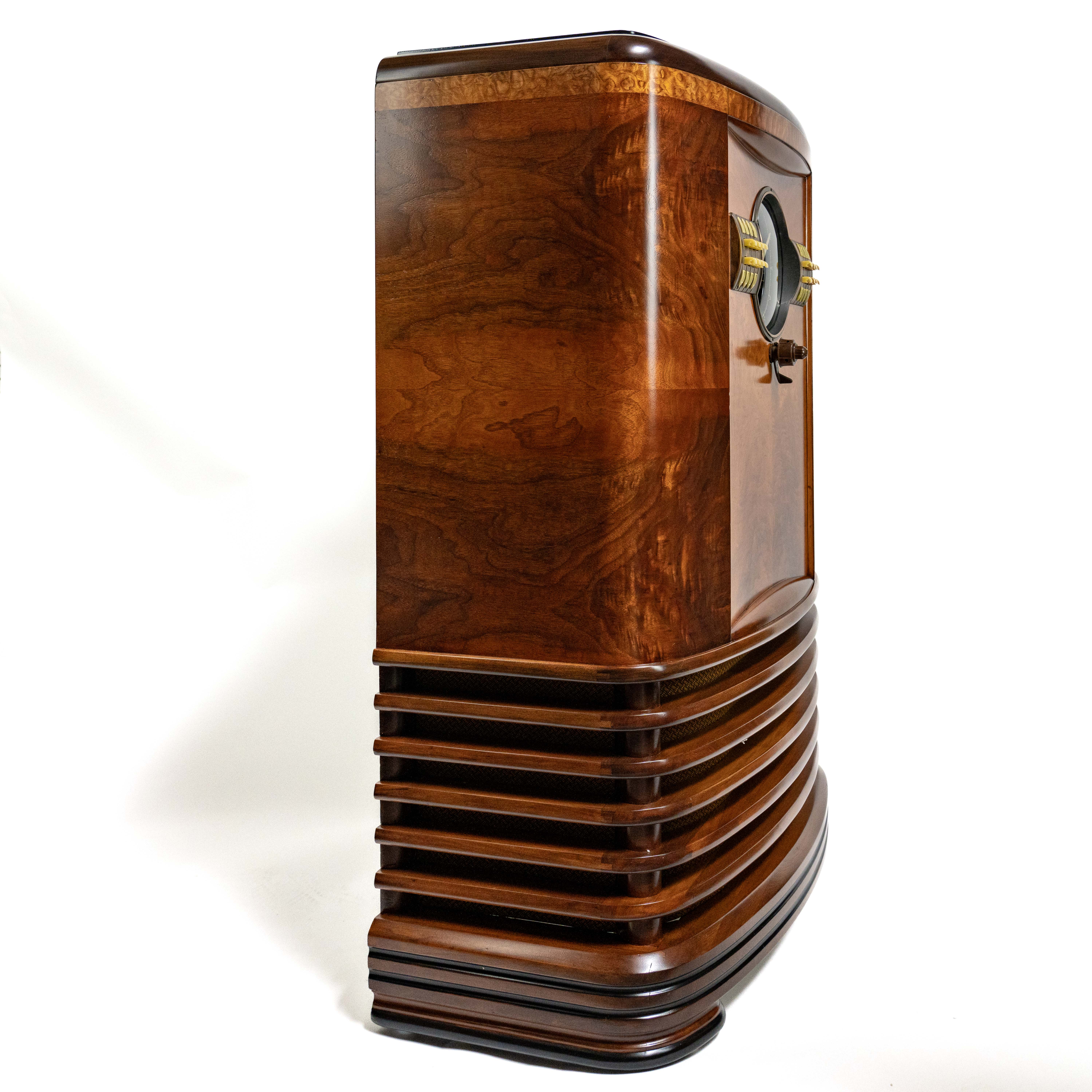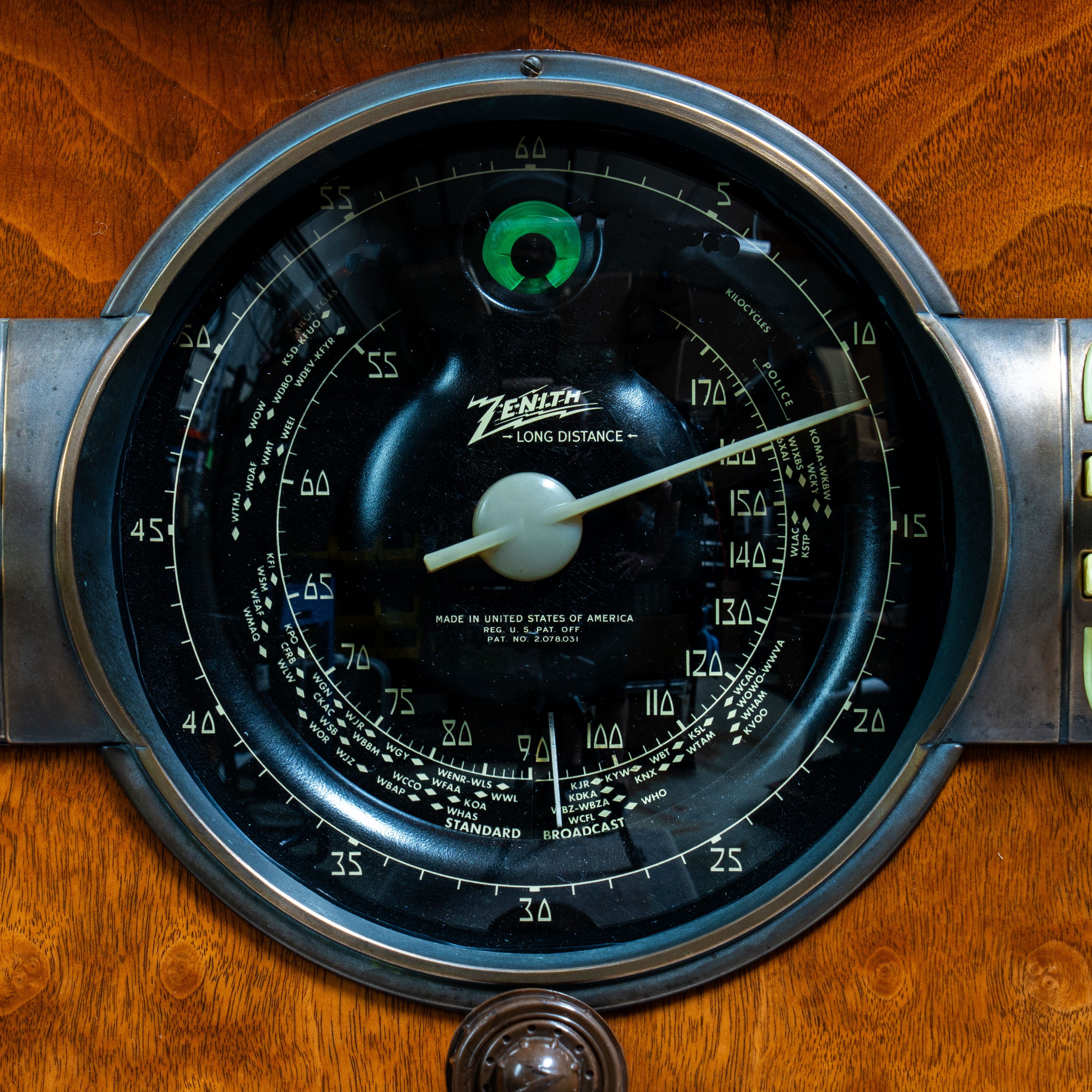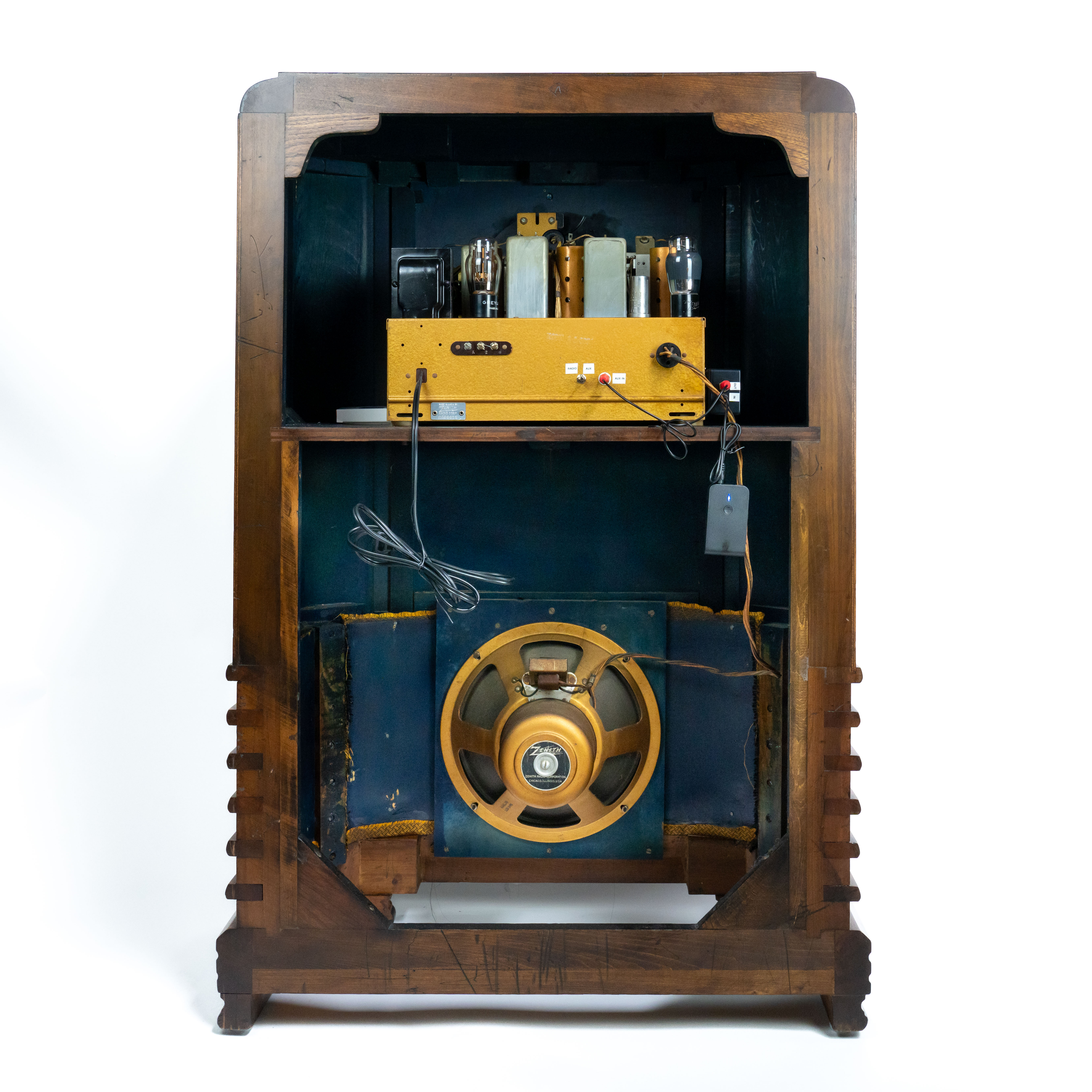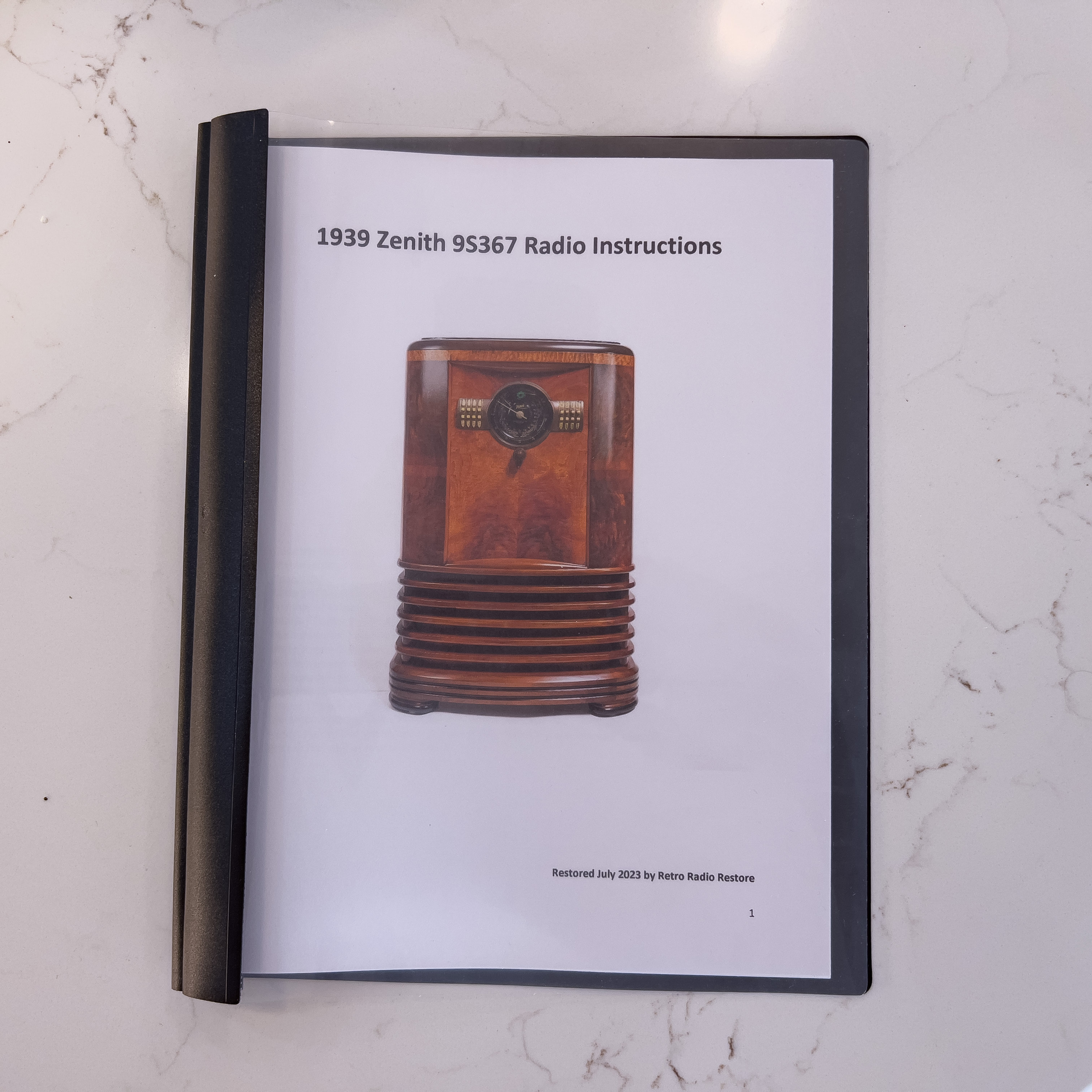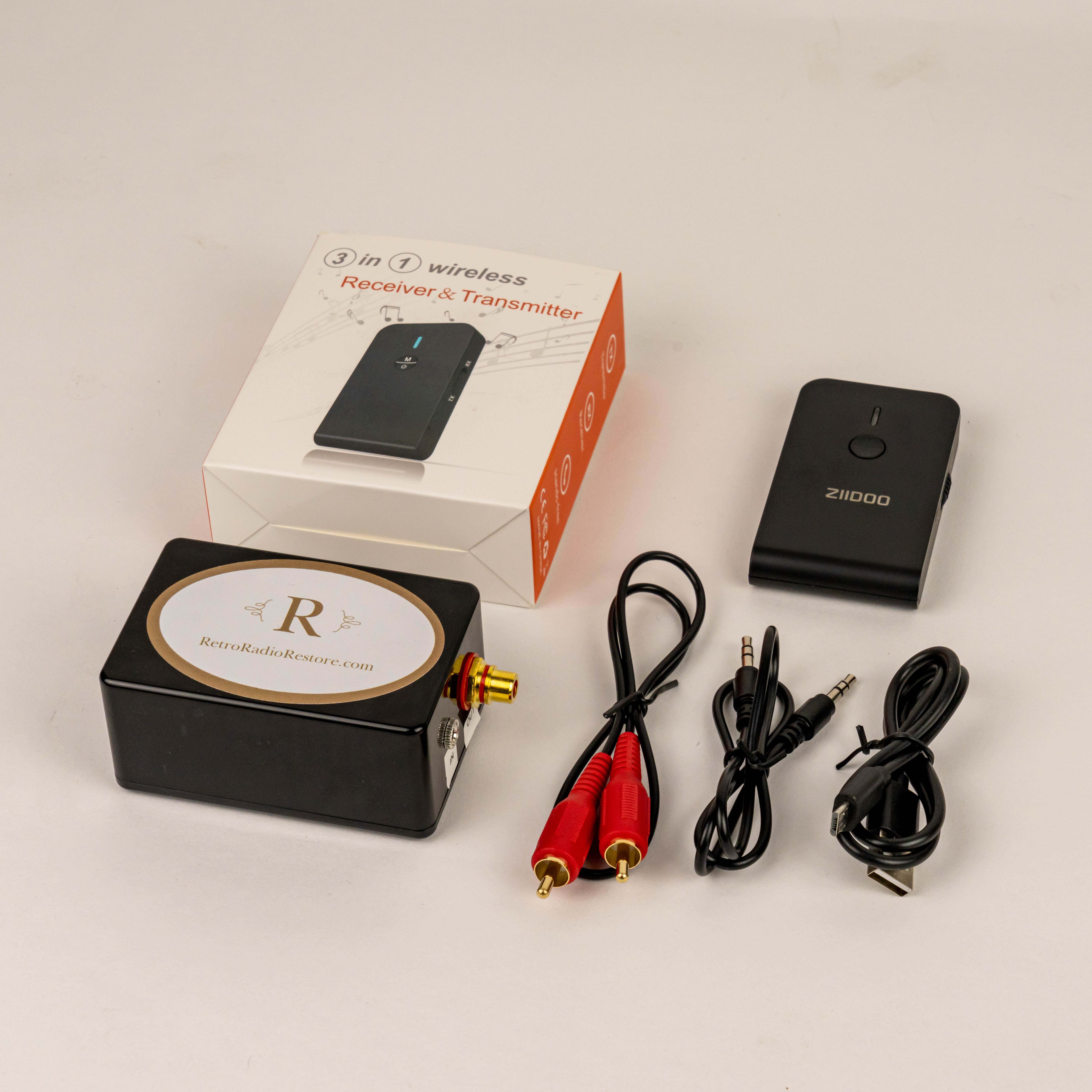- Radios
- >
- Zenith 9S367 'Zephyr' Console (1939)
Zenith 9S367 'Zephyr' Console (1939)
SKU:
$2,600.00
$2,600.00
Unavailable
per item
SOLD
This stunning 1939 Zenith 9S367 console radio is an excellent example of American craftsmanship from a bygone era. This is one of Zenith’s most famous and collectible models. It is a nine-tube, three-band radio sporting the innovative “Robot Shutter Dial” and green magic-eye tuning indicator. It has a big 12-inch speaker. The cabinet, with its wrap-around louvers, was referred to by Zenith as Zephyr style, after the streamlined Art Deco locomotives of the day. The cabinets’ book-matched walnut is beautifully refinished with an impeccable satin lacquer finish and toned lacquer color trim. This radio has had a complete electronic restoration and has been retrofitted with our exclusive Bluetooth / MP3 input. The radio picks up stations with the simplest antenna and the wood cabinet gives everything you play a deep, rich sound.
History – The Zenith 9-S-367 (9S367) was first introduced in the summer of 1938 as part of Zenith's line-up of 76 new models for 1939. Its introductory price in the East was $99.95. In addition to Zenith's "robot dial", which received a makeover from its inaugural 1938 model year, the 9S367 embodied two Zenith innovations new for 1939. The first was the Radiorgan, comprising 6 pull-tabs to the right of the dial used for controlling tone, with 64 combinations possible (the remaining two tabs to the right of the dial are for on and off). The second new feature was ‘Transcontinental Tip-Touch Automatic Tuning’, allowing instant selection of one of eight preset stations when the band-lever is in the 'automatic' position. Tip-Touch tuning is done electrically by switching in and out tuned circuits dedicated to each preset. Zenith made much of the fact that any standard broadcast station could be selected as a preset, local or distant. This was an advantage over the mechanical systems offered by some other manufacturers, which relied on Automatic-Frequency-Control (AFC) and consequently needed a relatively strong station to be preset in order to work reliably.
The 'Robot Dial' (or as it is sometimes referred to as the ‘Shutter Dial’) operates when the band lever is moved to change between bands. When this occurs an alternate dial or shutter is rotated into view, revealing the markings solely for the chosen band and rendering set operation less confusing for the listener. Zenith advertising claimed that "it's child's play to operate a Zenith” and “a child delights in doing it”, “the Robot Dial is Almost Human”, and “the greatest advancement in ease of tuning since the inception of radio".
Today, this attractive radio is sought after by collectors but seldom found in this condition. We acquired this one in early 2019 from a collector who had partially restored it. The cabinet was in good shape but had the original finish. The chassis was working but needed a full restoration and upgrade.
Cabinet – The cabinet got a complete restoration. We stripped the original finish and toned the top edge, piping pin stripes and footer, and added grain filler. The entire cabinet was sealed with a flat satin lacquer. This made the original multi-colored veneers and book-matched walnut veneers pop. We added period correct grille cloth and replaced the original control knobs with modern reproductions. The result is this handsome looking radio that will last many, many years into the future.
Dial – For the most part the dial was in good condition. However, the large outside black dial scale had cracked paint, so we stripped it, painted it, added a new decal, and restored to perfect condition. The rest of it was disassembled, cleaned, lubricated, aligned and reassembled. The cabinet dial glass was free and clear of any chips, breaks or cracks. The surrounding brass escutcheon was cleaned only enough to keep the original patina well into the future.
Chassis – We took extra steps and worked with the top expert at the California Historical Radio Society to ensure this radio produces no hum. We went through the entire underside of the chassis replacing all the capacitors, checking, and replacing resistors and wires where needed. It now plays very well across the dial and all bands even with the simplest of antennas. All tubes were checked and replaced where needed with NOS (new old stock) tubes. We cleaned and lubricated the main tuning capacitor gears and concentric tuning mechanism and flywheel for smooth tuning operation. A new power cord, fuse and voltage dropping resistor were installed for electrical safety. New silicone rubber chassis mounts were added for better vibration isolation. We added an auxiliary input and switch on the back and aligned the radio for the Bluetooth adapter.
Speaker – Even though it performed well, we had the all-original 12-inch speaker cleaned and reinforced. The result is clear audio across the entire audio frequency range. This radio produces exceptional bass tones for its size and the great sound will fill the room. See link to demo on YouTube below.
Bluetooth - Additionally, this radio has been fitted with our custom Bluetooth / MP3 adapter which allows you to switch between the radio or your smartphone or music device. Access your streaming audio service or the playlist on your smart device to provide classic tunes and bring the warm, bright, analogue sound to any music or recording you choose. The quality of the sound is excellent. You will have the best of “digital” and “analogue” combined.
Year of Manufacture: 1938/1939
Band Frequency Ranges:
AM Broadcast Band..............540 – 1800 KHz
Shortwave Band 1……………….2.2 – 7.8 MHz
Shortwave Band 2……………….7.5 – 25 MHz
See demo on YouTube here: youtu.be/4I9AhEdfdRw
History – The Zenith 9-S-367 (9S367) was first introduced in the summer of 1938 as part of Zenith's line-up of 76 new models for 1939. Its introductory price in the East was $99.95. In addition to Zenith's "robot dial", which received a makeover from its inaugural 1938 model year, the 9S367 embodied two Zenith innovations new for 1939. The first was the Radiorgan, comprising 6 pull-tabs to the right of the dial used for controlling tone, with 64 combinations possible (the remaining two tabs to the right of the dial are for on and off). The second new feature was ‘Transcontinental Tip-Touch Automatic Tuning’, allowing instant selection of one of eight preset stations when the band-lever is in the 'automatic' position. Tip-Touch tuning is done electrically by switching in and out tuned circuits dedicated to each preset. Zenith made much of the fact that any standard broadcast station could be selected as a preset, local or distant. This was an advantage over the mechanical systems offered by some other manufacturers, which relied on Automatic-Frequency-Control (AFC) and consequently needed a relatively strong station to be preset in order to work reliably.
The 'Robot Dial' (or as it is sometimes referred to as the ‘Shutter Dial’) operates when the band lever is moved to change between bands. When this occurs an alternate dial or shutter is rotated into view, revealing the markings solely for the chosen band and rendering set operation less confusing for the listener. Zenith advertising claimed that "it's child's play to operate a Zenith” and “a child delights in doing it”, “the Robot Dial is Almost Human”, and “the greatest advancement in ease of tuning since the inception of radio".
Today, this attractive radio is sought after by collectors but seldom found in this condition. We acquired this one in early 2019 from a collector who had partially restored it. The cabinet was in good shape but had the original finish. The chassis was working but needed a full restoration and upgrade.
Cabinet – The cabinet got a complete restoration. We stripped the original finish and toned the top edge, piping pin stripes and footer, and added grain filler. The entire cabinet was sealed with a flat satin lacquer. This made the original multi-colored veneers and book-matched walnut veneers pop. We added period correct grille cloth and replaced the original control knobs with modern reproductions. The result is this handsome looking radio that will last many, many years into the future.
Dial – For the most part the dial was in good condition. However, the large outside black dial scale had cracked paint, so we stripped it, painted it, added a new decal, and restored to perfect condition. The rest of it was disassembled, cleaned, lubricated, aligned and reassembled. The cabinet dial glass was free and clear of any chips, breaks or cracks. The surrounding brass escutcheon was cleaned only enough to keep the original patina well into the future.
Chassis – We took extra steps and worked with the top expert at the California Historical Radio Society to ensure this radio produces no hum. We went through the entire underside of the chassis replacing all the capacitors, checking, and replacing resistors and wires where needed. It now plays very well across the dial and all bands even with the simplest of antennas. All tubes were checked and replaced where needed with NOS (new old stock) tubes. We cleaned and lubricated the main tuning capacitor gears and concentric tuning mechanism and flywheel for smooth tuning operation. A new power cord, fuse and voltage dropping resistor were installed for electrical safety. New silicone rubber chassis mounts were added for better vibration isolation. We added an auxiliary input and switch on the back and aligned the radio for the Bluetooth adapter.
Speaker – Even though it performed well, we had the all-original 12-inch speaker cleaned and reinforced. The result is clear audio across the entire audio frequency range. This radio produces exceptional bass tones for its size and the great sound will fill the room. See link to demo on YouTube below.
Bluetooth - Additionally, this radio has been fitted with our custom Bluetooth / MP3 adapter which allows you to switch between the radio or your smartphone or music device. Access your streaming audio service or the playlist on your smart device to provide classic tunes and bring the warm, bright, analogue sound to any music or recording you choose. The quality of the sound is excellent. You will have the best of “digital” and “analogue” combined.
Year of Manufacture: 1938/1939
Band Frequency Ranges:
AM Broadcast Band..............540 – 1800 KHz
Shortwave Band 1……………….2.2 – 7.8 MHz
Shortwave Band 2……………….7.5 – 25 MHz
See demo on YouTube here: youtu.be/4I9AhEdfdRw
